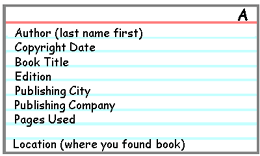Background Research
YOU are now about to become the EXPERT on your topic or problem. You need to find out everything about your topic including the variables that could be tested and what scientists are still wondering about. This will allow you to develop a problem or question that can be solved or answered by experimentation.
Where should I look?
Don't think you will find everything you need in one day. Information will not just jump out at you and say, “Here I am!, this is exactly what you need.” Likewise, your research will not be found in just one or two reference books. Spend time in the library and on the internet. Make a list of keywords that might guide your research.
For a project on plant growth you might list:
- Botany
- Leaves
- Photosynthesis
- Sunlight
A little research using those words might lead you to new keywords such as:
- Starch
- Wavelength
- Chlorophyll
- Pigment
- Stomate
- Carbon Dioxide
What am I looking for?
Your research should cover:
- Background information – general information about your problem that might include:
- Definition and/or explanation of the topic or problem
- Definition and/or explanation of terms found in the problem
- Information about topics that relate to the problem
- Explanation of why it is important to know about this problem
- Specific Information, including:
- Results from other experiments similar to yours
- Studies done by companies or consumer groups that relate to your problem
- Information necessary to experiment safely
What do you do when you find useful information?
When you do find information that is related to your problem, you need to write down what source you got the information from as well as the information itself. There are several ways to keep this information, but the most organized way would be to use bibliography cards and note cards.
Bibliography cards
One of the best ways to set up your bibliography cards is using APA style. This will make it easier when you write your reference list for your research paper AND is needed for the Bibliography in the research plan. For each reference used, you will need to make a DIFFERENT bibliography card.


You will have a different letter for each different reference you use. If you used most of the book, do not put the page numbers. See the bibliography page to find out what information to record for other resources you might use.
Notecards
After you have found a reference and made a bibliography card for it, you are ready to read it and take notes. It is perfectly normal not to know exactly what information to take down as notes. Better to take too many than too few notes – it saves you time in the long run. Remember what you are looking for – information about your problem. This information is recorded on NOTE CARDS. These are your research notes from which you will eventually write a research paper.
Follow these guidlines for your note cards:
- Put the source of information (the letter used on your bibliography card) and the page number on each note card.
- Write only one idea or fact on each note card.
- Try not to copy information. Use ideas, facts, and phrases.
- If you do copy information, use quotation marks so you remember that you copied.
- Do not use any information in your science project research paper that is not on a note card – unless it is your opinion.


Now that I have all these cards, what do I do with them?
Lay out all your informational note cards and try to group them into three or four groups. These are the main ideas about your topic. Form an outline that gives a good flow of how the ideas on the cards are related. Your outline should show your thought process as you investigate the background of your topic, what others already know about your topic, and what questions might still need answers.